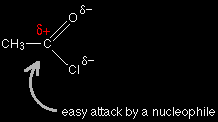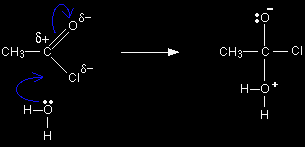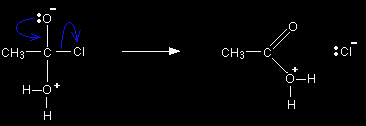EXPLAINING NUCLEOPHILIC ADDITION / ELIMINATION IN THE REACTION BETWEEN ACYL CHLORIDES AND WATERThis page guides you through the mechanism for the nucleophilic addition / elimination reaction between acyl chlorides (acid chlorides) and water. Ethanoyl chloride is taken as a typical acyl chloride. Any other acyl chloride will behave in the same way. Simply replace the CH3 group in what follows by anything else you want. |
|
|
Important! If you haven't already done so, it would help if you first read the page What is nucleophilic addition / elimination? before you go on. |
|
The reaction between ethanoyl chloride and waterWater as a nucleophile A nucleophile is a species (an ion or a molecule) which is strongly attracted to a region of positive charge in something else. 
Nucleophiles are either fully negative ions, or else have a strongly Oxygen is much more electronegative than hydrogen and so drags the electrons in the oxygen-hydrogen bonds towards itself. That produces a significant amount of negative charge on the oxygen atom. The oxygen also has two active lone pairs of electrons. One of these attacks the ethanoyl chloride. |
|
|
Note: If you aren't sure about electronegativity and bond polarity follow this link before you go on. Use the BACK button on your browser to return to this page. |
|
Why are acyl chlorides attacked by nucleophiles? The carbon atom in the -COCl group has both an oxygen atom and a chlorine atom attached to it. Both of these are very electronegative. They both pull electrons towards themselves, leaving the carbon atom quite positively charged. It is that carbon atom which is attacked by one of the lone pairs on the oxygen atom in a water molecule. The ethanoyl chloride molecule is also planar (flat) around that carbon atom, and that leaves plenty of room for a nucleophile to attack either from above or below the plane of the molecule.
The mechanism The reaction happens in two main stages - an addition stage, followed by an elimination stage. In the addition stage, a water molecule becomes attached to the carbon in the ethanoyl chloride. As the lone pair on the water approaches the fairly positive carbon in the ethanoyl chloride, it moves to form a bond with it. In the process, the two electrons in one of the carbon-oxygen bonds are repelled entirely onto the oxygen, leaving that oxygen negatively charged.
|
|
|
Note: Only one of the two lone pairs on the oxygen in water is shown because only one of them is involved in the reaction. There's no reason why you couldn't write both in if you want to - it just clutters the diagram. |
|
Notice that the oxygen atom in the water has gained a positive charge. The underlying reason for this is that when the lone pair forms a bond with the carbon, electrons are moving away from the oxygen. What matters, though, is that you remember to show the positive charge in an exam. Think of it like this: If you leave out the positive charge, two things are wrong with the equation:
You can put both things right with a positive charge on the oxygen. The elimination stage stage of the reaction happens in two steps. In the first, the carbon-oxygen double bond reforms. As the electron pair moves back to form a bond with the carbon, the pair of electrons in the carbon-chlorine bond are forced entirely onto the chlorine to give a chloride ion.
Finally, the chloride ion forms a bond with one of the hydrogens on the oxygen - removing it as a hydrogen ion. The electrons in the hydrogen-oxgyen bond move back onto the oxygen, cancelling the positive charge.
|
|



